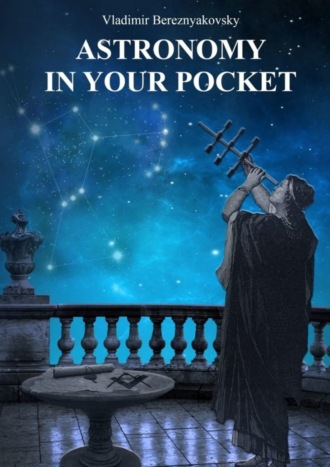
Полная версия
Astronomy in your pocket

Astronomy in your pocket
Vladimir Vladimirovich Bereznyakovsky
© Vladimir Vladimirovich Bereznyakovsky, 2020
ISBN 978-5-0051-0524-0
Created with Ridero smart publishing system
Introduction
For many people, astronomy has either remained on the covers of textbooks, or is a distant part of physics that is reluctantly studied in high schools and institutes. For modern man, surrounded by all sorts of irritants and living at a furious pace of the metropolis, every day it becomes more difficult to find time for himself, for questions to himself.
From early childhood to old age, we always have only one driving force-the desire to learn the unknown. The form of knowledge changes with age, but the brain’s thirst for new information remains the same. In childhood, we learn the world in all possible ways, and any information is new and interesting, but as we grow up, we find it difficult to find quality food for our brain, despite the fact that the requests remain the same.
Many philosophers and thinkers called the science of the cosmos the science of the universe, which thousands of great minds have tried and will try to understand. Rulers and generals linked significant dates of events to a certain arrangement of stars and planets in space, perfectly understanding the meaning and consequences of their actions. And the study of such a science as astronomy has always been a rare opportunity, because knowledge about the cosmos and its structure has almost never been publicly available.
Like any science, astronomy has its discoverers, its main objects of study, and its controversial topics. But every science has its own boundaries, and the main difference between the science of astronomy and others is that these boundaries are the boundaries of the Universe, the widest in all senses of the word. Everything that has ever been and will be created by man is enclosed within the boundaries of our planet, Solar system, and Universe. No one can break and go beyond these boundaries, but to study their properties and features is the main task of astronomy. That is why many of the great minds of mankind were obsessed with the idea of understanding the primordial laws of the Universe.
The name “Astronomy in your pocket” was chosen for a reason, because this book is a collection of the most important information about the cosmos, stars, planets and their discoverers.
I. THE GREAT EXPLORERS
EGYPT
In Ancient Egypt, there was a complex mythology with many gods, and the astronomical ideas of the Egyptians were closely related to it. The Egyptian priests were the wisest astronomers of the time. Even then, the so-called schematic calendar was introduced, in which the year was divided into 12 months and contained 365 days, but the Egyptians knew that the true year is 6 hours longer. Egyptian priests had to perform night services to the God RA, so in order to determine the time not only during the day, but also at night, around 1500 BC, so-called star clocks were created based on the position of the stars in the night sky.
Of course, we can not say about the pyramid of Cheops, whose faces were oriented exactly to the cardinal directions, and the four corners of the pyramid pointed to the four signs of the zodiac: Taurus, Leo, Scorpio and Aquarius. The brightest stars in these constellations – Aldebaran, Regulus, Antares, and Fomalhaut – maintain the same distance from each other and are even now used as stable landmarks. It should be noted that the Egyptian astronomers could measure with great accuracy the distance between the stars and their position in space, because the location of the pyramids of Cheops, Chephren and mycerinus in the Giza pyramid complex coincides in all respects with the location of the stars Alnitak, Alnilam and mintaka in the constellation of Orion. The ancient Egyptians divided the sky into constellations, used the gnomon*, measured the height of the Sun above the horizon, knew six planets, and were even able to divide them into groups. It would seem that the Egyptians, a settled people, did not need astronomy, because the terms of agricultural work showed them the river Nile, yet it was on the Egyptian land in Alexandria that later worked Aristarchus of Samos, Eratosthenes, Timocharis, using the works of the priests, and the schematic calendar of the Egyptians used in their calculations Ptolemy and even Copernicus. We should also remember that one hour equal to 1/24 of the length of the day was offered to the world by the ancient Egyptians.

*Gnomon – the oldest astronomical instrument, which is a vertical object (obelisk, pole), allowing the length of its shadow to determine the angular height of the Sun. The gnomon is also called the part of a sundial, the shadow of which is determined by time.
EUROPE
The oldest megalithic monument in Europe associated with astronomy is considered to be Newgrange in Ireland, near Dublin. The Newgrange dates from about 3000 BC and is a mound 13.5 meters high and 85 meters in diameter. A 19-meter tunnel leads to the burial chamber, which is based on vertically placed stone monoliths weighing from 20 to 40 tons. The walls of Newgrange are painted with strange different circles and spirals, symbolizing the rings of time. The tunnel is oriented to the Southeast-exactly where the sun rises on the day of the winter solstice. Unlike the much later Stonehenge (about 1750 BC), which is 82 megaliths weighing 5 tons each, 30 stone blocks (25 tons each) and 5 huge trilithons weighing 50 tons, the functions of Newgrange included only one astronomical operation: determining the beginning of the year, which its builders associated with December 21; while Stonehenge was an ancient astronomical Observatory, in which observations of the Sun, Moon and other planets were made. However, archaeologists and astronomers still have many questions about the technology of construction of such structures and their functionality.
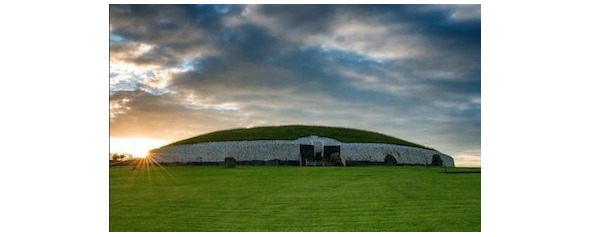
The Newgrange
NEW WORLD
On the plains of North America, a huge number of archaeological sites have been found in the form of stone circles on the tops of hills. The oldest is the circle at Mahorville in Canada, which was built around 2500 BC.
Big horn, one of the most important astronomical monuments, is located in the state of Wyoming, USA. big horn is a large group of stones, from which come “rays” about 12 meters long, at the ends of which a stone circle is drawn. At the ends of each of the six rays are heaped stone piles, and the direction of the southwest pile of stones coincides with the direction of sunrise on the day of the summer solstice. On the big horn, it was also possible to observe and study the sunrises of Sirius, Rigel, and Aldebaran.
The “star” pyramids of Ecuador are also a part of history that is very interesting for both archaeologists and astronomers. Not far from the capital of Ecuador, Quito, there is a complex of 15 truncated pyramids of various heights and squares. The estimated date of construction is 700—1200 ad, but interestingly, all ramps approach the pyramids from the northeast and are inclined at an angle of 10°, and the largest reaches 300 meters in length. It was in this direction that you could see the rising of the star Alcayde, which is located at the end of the constellation URSA Major. This star rises last of the seven stars of the constellation, but the interest of the Injuns was really connected with the harvest, because, since Algina appears at an altitude of 10°, and its sunrise falls at the end of October, for the Injuns this event meant the onset of the rainy season and the beginning of the agricultural year. This season in the tropical zone comes suddenly, threatening to catch landowners by surprise, which is why the inhabitants of Ecuador were so important astronomical methods of warning the elements.

The “star” pyramids of Ecuador
THE PRIESTS-MAYAN ASTRONOMERS
The ancient Mayan Injuns are considered to be the true intellectuals of pre-Columbian America. The Maya astronomer-priests spent their entire life observing from stone observatories-Caracoles (shells), knew five planets, and only from the priests were instructions about the beginning of agricultural work. About the economic direction of astronomical science, the Mayans say that they called the months: “harvest”, “deer” (hunting season), “cloud” (rainy season). Mayan priests even knew how to calculate solar and lunar eclipses, pretending that many natural phenomena are subject to them. Astronomy in their hands was an instrument of power that kept the people in fear and obedience. The Mayan calendar consisted of a 13-day week, a 20-day month, and a 365 – or 366-day year. Incredibly, it was the most accurate calendar in existence. An extra day in comparison with the true year would run up in it only after 10 thousand years. For comparison, the calendar of Caesar for 128 years gave an error per day, and even our modern – Gregorian-calendar for 3 thousand years gives an error per day.
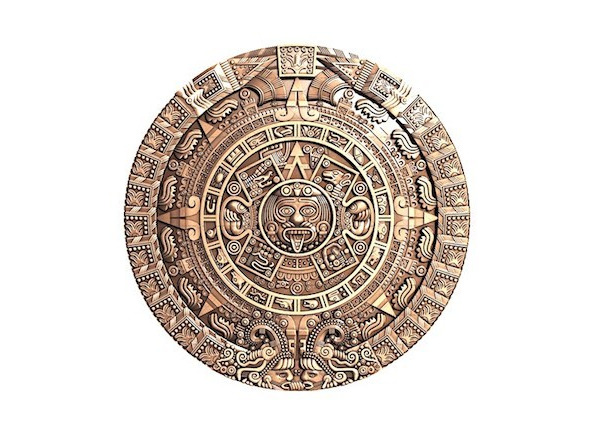
The Mayan calendar
ANCIENT ASTRONOMY
Ancient astronomy is a very important page in the history of science, because in Ancient Greece for almost two centuries that the fundamental foundations of the universe and the structure of the Universe were laid. The mathematical methods of ancient astronomers were later used by both medieval Arabs and European astronomers.
Eudoxus was an outstanding scientist of the fourth century. He was one of the most prominent mathematicians of antiquity: he developed the General theory of proportions and became the forerunner of modern integral calculus. It is very likely that Eudoxus is responsible for the proofs given by Aristotle about the spherical shape of the Earth, and even Archimedes mentions the ratio of distances to the moon and Sun calculated by Eudoxus (1:12).
It is impossible not to say about Aristotle, whose authority in the middle Ages really held back the progress of astronomy. The theory that the Earth is the center of the Universe, to which all objects tend, was very popular and accepted as an unshakable truth. But at the same time, it is in combination with this theory that Aristotle, in his book “On the sky”, proved the spherical nature of the Earth, using as arguments eclipses of the moon and observations of the stars.
Another ancient scientist who made a huge contribution to science is Eratosthenes. For the first time, he measured the length of the earth’s circumference fairly accurately, using a homemade device called a scaphis. Eratosthenes concluded that the earth’s circumference is 39,690 kilometers. If we take into account the unreliability of the initial data and the roughness of the measuring instruments, Eratosthenes actually approached the figure of 40 thousand kilometers, equal to the circumference of the Earth.
Aristarchus of Samos, who lived in the third century BC, can rightly be called the Copernicus of the ancient world, because he was the first to propose and try to prove the heliocentric model of the Solar system. He found that the Moon revolves around the Earth, and the Earth, in addition to turning around its axis, also turns around the Sun, and this movement is characteristic of all planets. Aristarchus also stated for the first time that all the stars in the night sky are mobile, and only because of their distance do we think that they are stationary. The theory of Aristarchus could not be accepted by his contemporaries, too much would have to be changed. It was impossible for scientists to believe that the Earth was also a celestial body like Mars and Venus, because then the thousand-year-old idea of the Sky would have collapsed. Rejecting heliocentrism, the scientist’s contemporaries accused him of blasphemy and banished him from Alexandria. Almost five centuries later, Ptolemy will find arguments that refute the movement of the Earth. It will take several epochs for heliocentrism to be accepted by humans.
NICOLAUS COPERNICUS
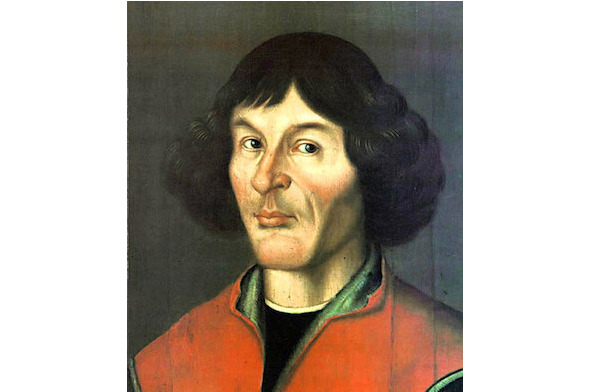
Nicholas Copernicus can rightly be considered the man who stopped the Sun and moved the Earth, because he was the first in Europe to formulate and scientifically justify the heliocentric system of the world.
Orphaned early, Copernicus was educated in Italy. While studying at the University, Nicolaus Copernicus showed excellent results in mathematics and theology, but it was then that he became particularly interested in astronomy. After receiving a doctorate in Canon law, Copernicus returned to his native Poland at the age of 30. Copernicus made all his notes in Latin or German – there is not a single paper known that he made in Polish. Copernicus had a perfect command of the ancient Greek language. Moreover, the first translation of a text from ancient Greek into Polish was made by him.
The first works of Copernicus, revealing the mechanics of the celestial bodies, were freely distributed and even admired in Church circles, but as soon as the Church realized that his work “undermines the foundations”, the books were banned. The main statements in the Copernicus heliocentric system were as follows: the celestial spheres and orbits do not have a common center, as Aristotle claimed; the center of the Earth is only the center of mass and the center of the moon’s orbit, not the center of the Universe; the distance between the Earth and the fixed stars is much greater than the distance between the Earth and the Sun, and all the planets move in orbits centered on the Sun. These statements completely contradicted the prevailing idea of the structure of the universe at that time, according to which the Central position in the Universe is occupied by a stationary Earth, around which the Sun, Moon, planets and stars rotate. In 1616 under Pope Paul V, the Catholic Church officially banned the Copernican theory and the protection of the heliocentric system of the world, since this interpretation contradicts the Scriptures, although the heliocentric model was still allowed to be used for mathematical calculations of the movement of the planets. Copernicus was also one of the first to Express the idea of universal gravitation.
Contrary to popular belief, no one burned Nicholas Copernicus at the stake. He lived a long life, and died at home at the age of 70. The grave of the great scientist was discovered only in 2008, the authenticity of his remains was confirmed by a DNA test.
ASTRONOMY OF THE EAST
The Arabs, having conquered the Arabian Peninsula, formed in the VIII – X century a powerful state – the Arab Caliphate. As early as the seventh century, the treasures of ancient science fell into the hands of the Arabs, but these manuscripts were fully translated and used only by the eighth and ninth centuries. Despite this, Arab scholars wrote many encyclopedic works and essays. In 1417—1420, the grandson of the famous Central Asian conqueror Tamerlane, Ulugbek built the most famous Observatory in the Middle and near East. Working at this Observatory, Arab scientists together with Ulugbek achieved significant results by determining and measuring the Equatorial and horizontal coordinates of the stars, the tilt of the Ecliptic to the equator, the position of the spring equinox, and stellar coordinates; a special table was created to calculate lunar eclipses.
JOHANN KEPLER
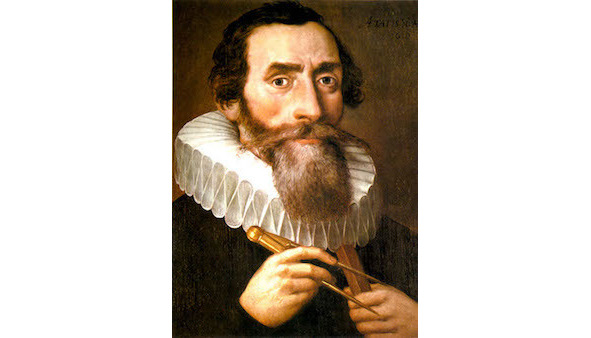
Johann Kepler was born in the German state of Stuttgart on December 27, 1571 in a poor Protestant family. At the age of six in 1577 Kepler first saw a comet, the same comet was observed and described by the Danish astronomer Tycho Brahe. In 1589 Kepler graduated from the school at the Maulbronn monastery, and for his outstanding abilities in almost all Sciences, the city authorities awarded him a scholarship to help him further his studies, but Johann was very sickly, ailments followed him all his life.
At the end of the XVI century in many cities of Europe, there was an open confrontation between groups of people who had different ideas about the structure of the Universe. And in 1600, both exiles – Kepler and Brahe – met in Prague, but it soon became clear that the way Kepler represented astronomy, Tycho Brahe shared only partially. To preserve the already relatively outdated model of the universe, according to which the Central position in the Universe is occupied by the stationary Earth, Brahe proposed a compromise model: all the planets, except the Earth, rotate around the Sun, and the Sun rotates around the stationary Earth (geo-heliocentric system of the world).
The three laws of planetary motion formed by Kepler gave answers to many questions related to the shape of the orbit and the speed of the planets.
Kepler’s first law (the law of ellipses): “Every planet’s orbit is an ellipse with the Sun at a focus.”
Kepler’s second law (law of squares): “Each planet moves in a plane passing through the center of the Sun, and for equal periods of time, the radius vector connecting the Sun and the planet covers equal areas.” In simple words, the Sun is not in the center of the ellipse that the planets move along, so the closer the planet is to the sun, the faster it moves in its orbit. For example, the speed of the Earth as it orbits the Sun changes every six months by about 4,000 km/h.
Kepler’s third law (harmonic law): “The Squares of the periods of the planets’ rotation around the Sun are referred to as cubes of the large semi-axes of the planets’ orbits”. In other words, when a planet approaches the Sun, the radius (half – axis) of its orbit decreases, but the speed, and therefore the time of movement (period) – increases.
Only in 1609, with great agony, Kepler managed to publish his works, in which the scientist explained not only the new astronomy and physics of the sky, but also for the first time found out what is the cause of ocean tides. Kepler absolutely proved that the Moon is the cause of tides. It was also Kepler who introduced the term “inertia” into physics as the innate property of bodies to resist an applied external force, forming in a clear form the first law of mechanics: “Any body that is not affected by other bodies is at rest or performs a uniform rectilinear motion.”
The works of Johannes Kepler on optical phenomena can be considered the beginning of optics as a science. In his works, he outlined geometric and physiological optics, described the General theory of lenses, light refraction, refraction, and the concept of an optical image. Kepler also discovered the role of the human lens for the first time, describing the causes of myopia and farsightedness, and an in-depth study of optical laws led Kepler to the scheme of a telescopic telescope (Kepler telescope).
Craters on the moon and Mars, a supernova, an orbiting Observatory, and a spacecraft were named in memory of the great scientist.
GALILEO GALILEI

Galileo was born in 1564 in Pisa and belonged to a ruined Florentine family. From an early age, the boy was attracted to art; all his life he was interested in music and drawing – he mastered them perfectly. In 1581, 17-year-old Galileo, at the insistence of his father, entered the University of Pisa to study medicine, but was passionately interested in geometry, and in 1592, Galileo received a place at the prestigious and rich University of Padua, where he taught astronomy, mechanics and mathematics. After learning about the invention of the telescope in Holland, Galileo decided to build his own telescope. In 1609. he assembled the first telescope and pointed it at the sky. Soon he was able to build a telescope that gives a magnification of 32 times. It is also important to note that the term “telescope” was introduced into science by Galileo. Using the telescope, which became the main instrument of all astronomers, Galileo Galilei saw the surface of the moon and discovered mountains and craters on the moon, and the milky Way broke up into separate clusters of stars. But even more surprisingly, Galileo was able to see as many as four moons of Jupiter. In Florence, Galileo continued his scientific research, discovering the phases of Venus, spots on the Sun, and then the rotation of the Sun around its axis.
Galileo was a very versatile man, who invented hydraulic scales, studied probability theory, created a prototype microscope with which he studied insects; also worked on the theory of color and magnetism, the resistance of materials, optics and acoustics. He was the first to experimentally measure the density of air. Galileo was a gifted writer and philosopher, and he was certainly the founder of both experimental and theoretical physics, and even Einstein called Galileo “the father of modern science”. He can be considered one of the founders of mechanism, because it is the analysis of mechanical movement that underlies his work. This scientific approach considers the Universe as a large mechanism, and complex natural processes as combinations of the simplest causes, the main of which is mechanical movement.
As you know, Galileo studied inertia and free fall, and in his last book formulated the laws of fall: “The speed increases in proportion to time, and the path increases in proportion to the square of time.” This contradicted the famous statements of Aristotle that the speed of falling is greater the greater the weight of the body. However, with the Catholic Church, things did not go so smoothly for Galileo. The fact is that the absolute majority of his works contained a variety of different statements and hypotheses that completely contradicted Aristotle, namely, the works of Aristotle built the medieval worldview. Seeing the obvious refutations of the geocentric system of the world and its fallacy, he decides to fight for the truth with the Catholic Church. His books violated the prohibition on promoting the “Pythagorean” doctrine, and Galileo was faced with a choice: either he would repent and renounce his “errors”, or he would suffer the fate of Giordano Bruno. Galileo confirmed that he agreed to recite the required recantation, and then was sentenced to prison. He spent the rest of his life under house arrest and the constant supervision of inquisitors. Galileo Galilei died on January 8, 1642, at the age of 78, in his bed. Pope Urban forbade the burial of Galileo in the family crypt in Florence. The greatest scientist of the middle Ages was buried without honors, and the head of the Catholic Church also did not allow to erect a monument. Officially, the Vatican rehabilitated Galileo Galilei only in 1992.
Among the most famous students of Galileo are Torricelli, who became a physicist and inventor, Castelli, the Creator of hydrometry, and Borelli, the founder of biomechanics. Craters, satellites, asteroids, and a NASA space probe were named in memory of the great scientist of the middle Ages.
ISAAC NEWTON
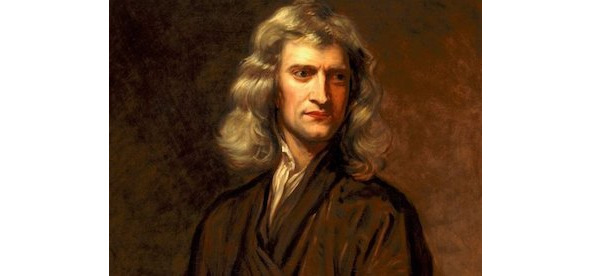
On Christmas night, 1642, a weak and quiet baby was born in the village of Woolsthorpe, named Isaac. Relatives did not baptize the baby at first, because they were afraid that the premature baby would not recover. Isaac’s mother was a widow, and he grew up without friends, and did not participate in noisy games that required skill and physical strength. Even as a child, he built a kind of water clock that measured time so accurately that soon the whole family began to use it. In 1655, 12-year-old Newton was sent to study at a nearby school in Grantham, where he lived in the house of an Apothecary. From the first lessons, the boy showed outstanding abilities. Isaac preferred all other pursuits to writing poetry, reading books, and constructing various mechanisms. In his youth, Isaac passionately devoted himself to writing poetry. After completing his education at school, Newton was able to continue his education at the University of Cambridge. More than 30 years of Newton’s life are associated with this educational institution. The basics of many Sciences were given to Newton without much difficulty, but despite the discoveries of Galileo, natural science and philosophy, Cambridge still taught according to Aristotle. After passing the exams, Isaac received a scholarship, but according to the memoirs of a roommate, Newton completely devoted himself to learning and science, forgetting food and sleep, and probably this is the way of life the young scientist desired for himself. By the age of 23, Isaac Newton was already considered a brilliant mathematician who made a number of discoveries.



